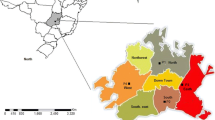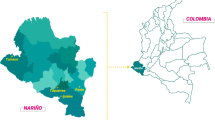Abstract
We evaluated the presence of DNA of Giardia, Toxoplasma, and Cryptosporidium by PCR, and of Giardia and Cryptosporidium genera by immunofluorescence antibody test (IFAT), in water samples, before, during, and after plant treatment for drinkable water. We applied this method in 38 samples of 10 l of water taken from each of the water treatment steps and in 8 samples taken at home (only for Toxoplasma PCR) in Quindio region in Colombia. There were 8 positive samples for Cryptosporidium parvum (21 %), 4 for Cryptosporidium hominis (10.5 %), 27 for Toxoplasma gondii (58.6 %), 2 for Giardia duodenalis assemblage A (5.2 %), and 5 for G. duodenalis assemblage B (13.1 %). By IFAT, 23 % were positive for Giardia and 21 % for Cryptosporidium. An almost perfect agreement was found between IFAT and combined results of PCR, by Kappa composite proportion analysis. PCR positive samples were significantly more frequent in untreated raw water for C. parvum (p = 0.02). High mean of fecal coliforms, high pH values, and low mean of chlorine residuals were strongly correlated with PCR positivity for G. duodenalis assemblage B. High pH value was correlated with PCR positivity for C. parvum. Phylogenetic analysis of DNA sequences was possible, showing water and human clinical sequences for Toxoplasma within the same phylogenetic group for B1 repeated sequence. PCR assay is complementary to IFAT assay for monitoring of protozoa in raw and drinkable water, enabling species identification and to look for phylogenetic analysis in protozoa from human and environmental sources.



Similar content being viewed by others
References
Alarcón M, Beltrán M, Cárdenas M, Campos M (2005) Recuento y determinación de viabilidad de Giardia spp. y Cryptosporidium spp. en aguas potables y residuales en la cuenca alta del rio Bogotá. Biomédica 25:353–365
Almeida JC, Martins FDC, Ferreira Neto JM, Santos MM, Garcia JL, Navarro IT, Kuroda EK, Freire RL (2015) Occurrence of Cryptosporidium spp. and Giardia spp. in a public water-treatment system, Paraná, Southern Brazil. Rev Bras Parasitol Vet 24:303–8
Alvarez C, de-la-Torre A, Vargas M, Herrera C, Uribe-Huertas LD, Lora F, Gómez-Marín JE (2015) Striking Divergence in Toxoplasma ROP16 Nucleotide Sequences From Human and Meat Samples. J Infect Dis 211:2006–2013
Aubert D, Villena I (2009) Detection of Toxoplasma gondii oocysts in water: proposition of a strategy and evaluation in Champagne-Ardenne Region, France. Mem Inst Oswaldo Cruz 104:290–5
Baldursson S, Karanis P (2011) Waterborne transmission of protozoan parasites: review of worldwide outbreaks—an update 2004–2010. Water Res 45:6603–6614
Berkman DS, Lescano AG, Gilman RH, Lopez SL, Black MM (2002) Effects of stunting, diarrhoeal disease, and parasitic infection during infancy on cognition in late childhood: a follow-up study. Lancet 359:564–571
Botero-Garcés JH, García-Montoya GM, Grisales-Patiño D, Aguirre-Acevedo DC, Alvarez-Uribe MC (2009) Giardia intestinalis and nutritional status in children participating in the complementary nutrition program, Antioquia, Colombia, May to October 2006. Revista do Instituto de Medicina Tropical de São Paulo 51:155–162
Castro-Hermida JA, González-Warleta M, Mezo M (2015) Cryptosporidium spp. and Giardia duodenalis as pathogenic contaminants of water in Galicia, Spain: the need for safe drinking water. Int J Hyg Environ Health 218:132–8
Ebner J, Koehler AV, Robertson G, Bradbury RS, Jex AR, Haydon SR, Stevens MA, Norton R, Joachim A, Gasser RB (2015) Genetic analysis of Giardia and Cryptosporidium from people in Northern Australia using PCR-based tools. Infect Genet Evol
Franco-Hernandez EN, Acosta A, Cortés-Vecino J, Gómez-Marín JE (2015) Survey for Toxoplasma gondii by PCR detection in meat for human consumption in Colombia. Parasitol Res
Gomez-Marin JE (2010) Protozoologia Medica, First. Manual Moderno, Bogota
Karanis P, Schoenen D, Seitz HM (1998) Distribution and removal of Giardia and Cryptosporidium in water supplies in Germany. Water Sci Technol 37:9–18
Karanis P, Sotiriadou I, Kartashev V, Kourenti C, Tsvetkova N, Stojanova K (2006) Occurrence of Giardia and Cryptosporidium in water supplies of Russia and Bulgaria. Environ Res 102:260–271
Kotloff KL, Nataro JP, Blackwelder WC, Nasrin D, Farag TH, Panchalingam S, Wu Y, Sow SO, Sur D, Breiman RF, Faruque AS, Zaidi AK, Saha D, Alonso PL, Tamboura B, Sanogo D, Onwuchekwa U, Manna B, Ramamurthy T, Kanungo S, Ochieng JB, Omore R, Oundo JO, Hossain A, Das SK, Ahmed S, Qureshi S, Quadri F, Adegbola RA, Antonio M, Hossain MJ, Akinsola A, Mandomando I, Nhampossa T, Acácio S, Biswas K, O’Reilly CE, Mintz ED, Berkeley LY, Muhsen K, Sommerfelt H, Robins-Browne RM, Levine MM (2013) Burden and aetiology of diarrhoeal disease in infants and young children in developing countries (the Global Enteric Multicenter Study, GEMS): a prospective, case-control study. Lancet 382:209–22
Lebbad M, Petersson I, Karlsson L, Botero-Kleiven S, Andersson JO, Svenungsson B, Svärd SG (2011) Multilocus genotyping of human Giardia isolates suggests limited zoonotic transmission and association between assemblage B and flatulence in children. PLoS Negl Trop Dis 5:e1262
Lopez-Castillo CA, Diaz-Ramirez J, Gomez-Marin JE (2005) Risk factors for Toxoplasma gondii infection in pregnant women in Armenia, Colombia. Rev Salud Publica 7:180–190
Ma L, Sotiriadou I, Cai Q, Karanis G, Wang G, Wang G, Lu Y, Li X, Karanis P (2014) Detection of Cryptosporidium and Giardia in agricultural and water environments in the Qinghai area of China by IFT and PCR. Parasitol Res 113:3177–84
Mahmoudi MR, Nazemalhosseini-Mojarad E, Karanis P (2015) Genotyping of Giardia lamblia and Entamoeba spp from river waters in Iran. Parasitol Res 114:4565–70
McCuin RM, Clancy JL (2003) Modifications to United States Environmental Protection Agency methods 1622 and 1623 for detection of Cryptosporidium oocysts and Giardia cysts in water. Appl Environ Microbiol 69:267–74
Muhsen K, Levine MM (2012) A systematic review and meta-analysis of the association between Giardia lamblia and endemic pediatric diarrhea in developing countries. Clin Infect Dis 55(Suppl 4):S271–S293
Ponce N, Gomez-Marin JE (2003) Estandarización y validación clínica de la prueba de reacción en cadena de la polimerasa (PCR) para diagnóstico de toxoplasmosis cerebral en pacientes infectados por el VIH. Infectio 7:8–14
Prystajecky N, Tsui CK, Hsiao WW, Uyaguari-Diaz MI, Ho J, Tang P, Isaac-Renton J (2015) Giardia spp. are commonly found in mixed assemblages in surface water, as revealed by molecular and whole-genome characterization. Appl Environ Microbiol 81:4827–34
Ramírez JD, Heredia RD, Hernández C, León CM, Moncada LI, Reyes P, Pinilla AE, Lopez MC (2015) Molecular diagnosis and genotype analysis of Giardia duodenalis in asymptomatic children from a rural area in central Colombia. Infect Genet Evol 32:208–13
Sotiriadou I, Karanis P (2008) Evaluation of loop-mediated isothermal amplification for detection of Toxoplasma gondii in water samples and comparative findings by polymerase chain reaction and immunofluorescence test (IFT). Diagn Microbiol Infect Dis 62:357–65
Sroka J, Wójcik-Fatla A, Dutkiewicz J (2006) Occurrence of Toxoplasma gondii in water from wells located on farms. Ann Agric Environ Med 13:169–75
Viera AJ, Garrett JM (2005) Understanding interobserver agreement: the kappa statistic. Fam Med 37:360–3
Wells B, Shaw H, Innocent G, Guido S, Hotchkiss E, Parigi M, Opsteegh M, Green J, Gillespie S, Innes EA, Katzer F (2015) Molecular detection of Toxoplasma gondii in water samples from Scotland and a comparison between the 529bp real-time PCR and ITS1 nested PCR. Water Res 87:175–181
Acknowledgments
Financed by grant 111356934687 from Colciencias (Colombian Scientific Government Agency). The funders had no role in study design, data collection and analysis, decision to publish, and preparation of the manuscript.
Author information
Authors and Affiliations
Corresponding author
Ethics declarations
Conflict of interest
None declared.
Rights and permissions
About this article
Cite this article
Triviño-Valencia, J., Lora, F., Zuluaga, J.D. et al. Detection by PCR of pathogenic protozoa in raw and drinkable water samples in Colombia. Parasitol Res 115, 1789–1797 (2016). https://doi.org/10.1007/s00436-016-4917-5
Received:
Accepted:
Published:
Issue Date:
DOI: https://doi.org/10.1007/s00436-016-4917-5




